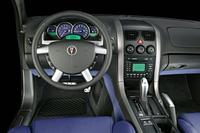Pontiac GTO History and Trivia
By Carey Russ
Back in 1964, Pontiac did not invent the GTO name. They copied it from Ferrari. Ferrari designated its Grand Touring (GT) category race car GTO, for Gran Turismo Omologato, Italian for ``homologated Grand Touring,'' and meaning that is was certified as a production car for racing. The rules of the day stated that 100 copies of any car needed to be built for it to be considered for the GT class; somewhere around 30 Ferrari GTOs were actually made. Ferrari took advantage of a loophole in the regulations that allowed re-bodying of cars, and claimed that underneath its aluminum skin the GTO was just like the hundreds of 250 GT models that had been made to that date. The Ferrari GTO was the last of the front-engined Ferrari race cars, and genuine examples are worth many millions of dollars today.
The Pontiac GTO caused a furor among sports car enthusiasts when it made its debut, but if Ferrari ever noticed, it said nothing. The two cars were hardly direct competitors, and could be told apart by anyone, enthusiast or not. They did share body-on-frame construction and a suspension with a live rear axle. The Pontiac GTO had admirable performance and handling for an American car of the time, and was reasonably small, really the closest thing to a ``sports sedan,'' had that term been in use at the time. Considered an ``intermediate'' car - between full-sized and compact - it had a 115-inch wheelbase, was 203 inches long, and weighed 3256 lbs. Compare that with the 2004 model's 110-inch wheelbase, 190-inch length, and 3725-lb weight. The new GTO is smaller and heavier, with much of the weight from comfort and safety devices and technologies that didn't exist 40 years ago.
Power ratings are, at a glance, similar. Today's GTO makes 350 horsepower and 365 lb-ft of torque from its 346 cubic-inch engine; the original made 348 horses and 428 lb-ft from 389 cubic inches (6.4 liters). But in those days, published horsepower ratings were gross (without engine accessories) rather than the more conservative net ratings today. Still, even if the old GTO's 348 horses are more like 300, the two cars have similar power-to-weight ratios, and GTOs were ferocious at the drag strip. With better traction from current tires, and vastly-improved brakes and a sophisticated fully-independent suspension, today's GTO can undoubtedly out-accelerate and out-brake an old one on the strip, and lap a road course far more quickly. Its more-efficient fuel-injected engine and six-speed transmission also give it far better fuel efficiency, with 15 to 20 mpg when pushed hard and up to nearly 30 mpg loafing on the highway. An old GTO will be doing well to break 15mpg no matter what. Such is modern technology, but there is a certain amount of character to a multiple-carburetor engine that does not translate to modern fuel-injection technology.
The 2004 GTO is not an exercise in nostalgia, but an update of the original muscle car concept. And that is a classic: powerful engine in a rear-wheel drive chassis for best acceleration and handling, and reasonably low-tech for a reasonable price. If the LS-1 lacks multiple valves and overhead cams, it's still a very sophisticated pushrod engine, with an aluminum block and heads. And it packs quite a punch, although it needs to be revved in order to get the most power. It doesn't have the low-end punch of some older muscle-car engines, but that will save on tires, clutches, and drivetrain parts....
With the safety and emissions laws of the late 1960s and early 1970s, the Pontiac GTO, like all other muscle cars, took some major hits to performance. By the time it was dropped in 1973, it was a cosmetic shadow of its former self. Although rumors about a new GTO occasionally surfaced, they were merely rumors. Ten years ago, at the full-line press launch for 1994 models, Pontiac brought an experimental prototype out for members of the press to drive around Heartland Park Raceway. Just about the first question asked was ``Is this the new GTO?'' ``No!'' was the answer, and for good reason. The little beast was, if my memory is working, a Grand Am with a seriously-boosted turbo Quad4 engine driving the front wheels. It was quick, it was nasty, but even then Pontiac realized that a GTO should be a rear-wheel drive, V8-powered car. Let other manufacturers besmirch once-revered names by bring them back in an incorrect manner.
Meanwhile thousands of miles away in Australia.... American manufacturers have had Australian operations for many years, and in many ways the two countries are similar. Only in Australia and the U.S. are vast distances routinely covered between towns, and in the Australian Outback distances are longer than even in the American West, and population densities lower. Big V8 engines were popular in Australia, as they were lightly-stressed and reliable. And the Aussies took to muscle cars just like Americans, with examples from both GM (sold under the Holden name) and Ford surviving long after they disappeared from America. As safety and emissions regulations converged worldwide, it became easier for manufacturers to use the same chassis and engines platforms worldwide. So it was only a matter of time before someone in a position of power at GM took a look down under and realized that there were cars that American enthusiasts could love. In particular, for a two-door coupe with the classic front-engine, rear-wheel drive layout and with a V8 engine and fully-independent suspension as bonuses, there was the Holden Monaro. If it could be made to comply with American safety and emissions regulations, it could work in America.
The Monaro (and the related Commodore sedan and some very interesting other vehicles) already used the local version of the aluminum LS-1 V8 found in the Corvette (and previously in the Firebird and Camaro) so a US-legal powertrain was no problem. Structural modifications to meet safety requirements could be done. But Australians, like the British, drive on the left side of the road, with the steering wheel on the right side of the car. Fortunately there were no structural barriers to left-hand drive conversion, and so, with a few cosmetic changes the Monaro comes to America as the latest Pontiac GTO.




